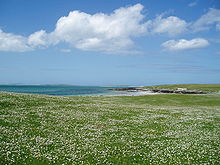- Northern Colletes
-
Northern Colletes Scientific classification Kingdom: Animalia Phylum: Arthropoda Class: Insecta Order: Hymenoptera Suborder: Apocrita Family: Colletidae Genus: Colletes Species: C. floralis Binomial name Colletes floralis
Eversmann, 1852The Northern Colletes (Colletes floralis) is a species of bee within the genus Colletes. Northern Colletes are solitary bees, though females may nest in what are termed aggregations – sites where the bees nest close together, but do not form colonies as social bees do.[1] They nest underground in soft (often sandy) soil, digging burrows up to 20 times the length of their bodies.[2] It is often to be found nesting in coastal sand dunes and, on Hebridean islands, machair (coastal grassland).[3]
Contents
Appearance
The bees are medium sized (with a head-to-body length of around 8–15 mm) and slender. They have a black abdomen, with narrow white bands on each segment. Tawny hairs cover the top of the thorax, with somewhat paler hairs on the face. They are very similar to other species within the Colletes genus and, if more than one of these species shares the same habitat, microscopic exmination can be necessary to distinguish between them. Females are slightly larger than the males, possessing slightly longer abdomens, which are also darker and glossier.[4][5]
Life cycle
Adult Northern Colletes emerge in late June, and are active until late August. The bees are active only when the temperature is warm. The males emerge one or two days before the females. The females probably mate soon after emergence. The males then die, while the female constructs a burrow which may be as much as 26 cm deep. The female produces a secretion from glands in the mouth, forming a cellophane-like coating[6] for the burrow. Each egg is sealed inside an individual cell, with enough regurgitated nectar and pollen to feed the larva throughout the winter. The larva lives underground, pupating in its burrow and emerging the following June as an adult. As Northern Colletes do not form colonies, there are no worker bees.[4][5][7]
Distribution
This is a rare bee. It can be found in Britain and Ireland, where it nests on the coasts of Ireland [8]and northern England, while in Scotland it can be found on islands as well as coastal areas of the mainland. Elsewhere in Northern Europe, it is present in low densities in Scandinavia, again in coastal areas.[4][7] It appears to prefer south-facing slopes with low, sparse vegetation; the bee forages in nearby flower-rich areas.[9] In Southern Europe, however, it inhabits higher altitudes, being found in the Pyrenees, Carpathians and Altay Mountains.[4][7]
One of the most significant habitats for this species of bee is the machair (coastal duneland) of the Outer Hebrides in Scotland where it was reported in September, 2007 that eleven previously unknown colonies had been discovered.[1][2]
Conservation
The bee has been assessed under IUCN regional red list guidelines for the island of Ireland. The species has a threat category of Vulnerable in Ireland [10]. The species is a UK Biodiversity Action Plan (BAP) species and a species action plan has been published for Northern Ireland in 2006 [11]
See also
External links
References
- ^ a b Ross, David (2007-09-13). "Rare species of burrowing bee has flourished in Outer Hebrides". The Herald. http://www.theherald.co.uk/news/news/display.var.1684785.0.0.php.
- ^ a b Smith, Lewis (2007-09-13). "Rare bee finds haven on islands". Times Online. http://www.timesonline.co.uk/tol/news/uk/article2441807.ece.
- ^ "The northern Colletes (Colletes floralis)". Naturally Scottish. Scottish Natural Heritage. http://www.snh.org.uk/scottish/species/invertebrates/colletes.asp. Retrieved 2007-09-14.
- ^ a b c d "Northern colletes (Colletes floralis)". ARKive. http://www.arkive.org/species/ARK/invertebrates_terrestrial_and_freshwater/Colletes_floralis/more_info.html. Retrieved 2007-09-14.
- ^ a b "Colletes floralis – Northern Colletes". HabitasOnline. National Museums Northern Ireland. http://habitas.org.uk/priority/species.asp?item=9599. Retrieved 2007-09-14.
- ^ "About the Northern Colletes bee". Royal Society for the Protection of Birds. http://www.rspb.org.uk/ourwork/conservation/biodiversity/keyspecies/invertebrates/colletesbee/about.asp. Retrieved 2007-09-14.
- ^ a b c "Remote Scottish islands a stronghold for one of the UK's rarest insects" (Press release). Royal Society for the Protection of Birds. 2007-09-13. http://www.rspb.org.uk/media/releases/details.asp?id=tcm:9-169804.
- ^ http://www.tcd.ie/Zoology/research/Bees/display_record.php?id=53#Colletes_floralis
- ^ "Details for Colletes floralis Eversmann". National Biodiversity Network's Species Dictionary. Natural History Museum. http://nbn.nhm.ac.uk/nhm/bin/nbntaxa.dll/taxon_details?taxon_key=NBNSYS0000009599. Retrieved 2007-09-14.
- ^ Fitzpatrick, U., T.E. Murray, A. Byrne, R.J. Paxton & M.J.F. Brown (2006) "Regional red list of Irish Bees (PDF)". Report to National Parks and Wildlife
- ^ Anon. 2006. Action plan details - Northern Ireland Action Plans. http://ukbap-reporting.org.uk/plans/lbap_complete_plan.asp?NI=1&X=%7BF5EDB283%2DD649%2D46E4%2DB04E%2DA308A9B09968%7D
Categories:- Bees
- Hymenoptera of Europe
- Conservation in Scotland
Wikimedia Foundation. 2010.

